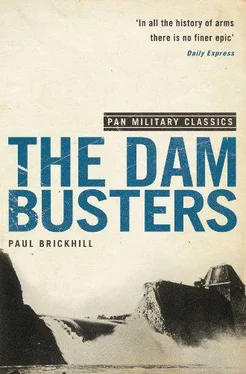Wallis probed at this problem for days and every time he probed he came slap up against the same old problem—the only way would be to drop something from very, very low and somehow make it stay where it was supposed to. But that seemed to be impossible. He remembered his last holiday with the youngsters just before the war began when they had been skipping stones across the smooth water of a little pond. How on earth, he thought, could one toss a stone low like that and stop it skipping. Drop any shape of bomb very low at a couple of hundred miles an hour and heaven knows where it would skip to. When dams are full there is practically no space between the level of the water and the top of the dam wall and in his wry imagination he visualised a series of grotesque bombs hurdling over the dam wall and flying harmlessly downstream. What a pity, he thought idly, that you couldn’t make a torpedo do a bit of hurdling—over an anti-torpedo net for instance.
Hullo! That was an idea! If a bomb could hurdle a dam wall it could also hurdle an anti-torpedo net. Such nets were a good hundred yards away from dam walls to keep any explosions at arm’s length. A bomb didn’t have to keep skipping for ever. May be it could be so judged to skip the torpedo net and not skip the dam wall. Hang it all, why not? He felt sudden excitement surging inside him. There would probably be three or four feet of dam wall above the water. Supposing the skipping of the bomb were timed (if it could be done) so that it was slithering to a stop on the water as it reached the wall. Why then, the wall would stop it dead and it would simply sink into the water, by the wall, as deep as you like. You could have the fuse fixed with a hydrostatic trigger so that the bomb would go off when the water pressure reached the right amount. Set in for fifty feet down or a hundred and fifty feet down. Please yourself. Hang it, the more he thought about it the more he liked the idea, even if it did sound a bit odd.
Wallis went home, dragged a tub into the garden of his house at Effingham and filled it right to the top with water. Then he rigged up a catapult a few feet away just a few inches above the level of the water. A few feet on the other side of the tub he stretched a string between a couple of sticks so that the string was also just above the level of the water. Then he borrowed a marble from his young daughter, Elizabeth, and shot it from the catapult at the water. It skipped off and cleared the string by several inches. Elizabeth and the other children looked on, wondering what he was up to. Elizabeth brought the marble back and Wallis fired it again, this time with a little less tension on the rubber of the catapult. The marble zipped off the water and only just cleared the string. “Ah,” thought Wallis, “that’s it.”
He and the youngsters spent the whole morning playing with the marbles and the water and the catapult and the string, trying different combinations of power and height while Wallis was finding out how much he could control the skip. To his deep joy he found out that with a regular shape and weight like a marble on smooth water he could control it quite well. At least well enough for it to be distinctly encouraging. But could he control several skips, which might be necessary? Aha, that remained to be seen. They went into lunch eventually, all thoroughly splashed. Wallis was very cheerful, and also, the children thought, very mysterious about it all.
Always sensitive to ridicule, Wallis told no one the details, not even his friend Mutt Summers, chief test pilot for Vickers and the man who had tested his old warhorse, the Wellington. Captain Summers was a hefty extrovert and not the type to take a freak idea seriously.
The day of the meeting of the Air Attack on Dams Committee Wallis went early to London, buttonholed the chairman, Dr. Pye, and privately explained his new theory, so earnestly that Pye did not laugh though he looked a little sideways.
“I’d rather you didn’t tell the others yet,” Wallis said. “They might think it a bit far-fetched.”
“Yes,” said Dr. Pye. “I see that. What do you want me to do?”
“Give me time to find out how much RDX will blow a hole in the Moehne Dam if it’s pressed up against the wall.”
Pye talked eloquently to the committee without giving Wallis’s secret away. The members were reluctant when they heard the results of the last model’s test and Wallis was like a cat on hot bricks till they consented to one more experiment.
Glanville built him a new model dam, and Wallis started with small charges, sinking them in the water and exploding them when they were lying against the slabs of concrete. The effect was shattering—literally. He smashed wall after wall seeking the smallest charge needed, and soon he knew that in a contact explosion tamped by water a tiny plug of a few ounces of gelignite blasted a satisfying hole through a concrete wall 6 inches thick. From that he calculated he would need only 6,000 Ib. of RDX to breach the Moehne Dam. With his new idea he could cut the case weight down to a little over 3,000 Ib., making the complete bomb about 9,500 Ib. Less than 5 tons. The new four-engined Lancasters would carry that to the Ruhr without trouble.
CHAPTER III
THE GREEN LIGHT
ARMED with sums and theories, Wallis faced the task of convincing officials in their brick and stone lairs along Whitehall and other influential thoroughfares that he could put his bomb in the exact spot. He called on Professor Patrick Blackett, director of an “operational research” branch, and Blackett, a spare, rather intense man, listened to his ideas, carefully examined the calculations, riffled them back into a neat pile and said quietly:
“We’ve been looking for this for two years.”
Wallis was electrified.
“I’d like you to leave these with me for a while,” Blackett said. “There are one or two people I know who would be interested.”
Blackett moved fast. As soon as Wallis had left he went to see Sir Henry Tizard and told him what he had heard. Tizard also moved with unorthodox haste, driving down to Weybridge next morning, where Wallis eagerly explained it all again.
“It seems,” Tizard said when he had finished, “that the main thing to establish is whether this freak of yours will really work, and if so how we go about putting it into practice.”
At Teddington, he said, was a huge ship-testing tank which would be ideal for experiments. He also thought there should be more tests to check how much explosive would theoretically punch a hole in a dam.
“I think I know just the thing,” said Wallis, whose “damology” researches had been fanatical. “There’s a small disused dam in Radnorshire; no earthly use any more as a dam and won’t ever be. We could try and knock it down.”
“Who owns it?” Tizard asked.
“Birmingham Corporation.” Wallis knew all the answers.
“We’ll try them,” Tizard said, and Birmingham Corporation, with a little prodding, said yes.
It was a nice little dam, about 150 feet long and quite thick, curving gracefully across the mouth of a reach of Rhayader Lake, high in the Welsh hills west of Leominster. The corporation had built a bigger dam across the mouth of the lake to feed a little river that tumbled out of the hills.
Wallis estimated that the old dam would have a fifth of the resistance of the Moehne, an ideal test model. He calculated the smallest charge that should knock it down and set off with a packet of RDX and some explosives engineers. Wrapped against the raw mountain wind, he wasted little time, measured out the charge, tamped it in a sealed casing and lowered it deep into the water against the dam wall. Behind the rocks, his mouth dry with anxiety, he pressed the plunger and the lulls echoed with sound. Water spurted a hundred feet high, the lake whipped into fury, and as the water plunged back into the void, the concrete crumbled and a hissing flood burst into the main lake. Wallis, pink with glee, saw there was a ragged hole in the dam 15 feet across and about 12 feet deep.
Читать дальше












